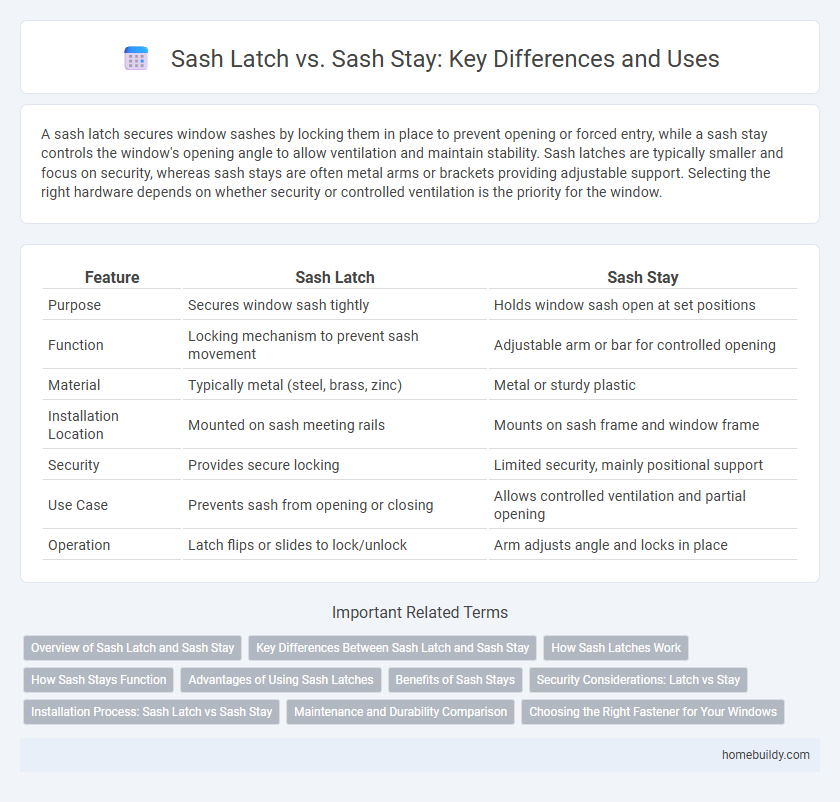A sash latch secures window sashes by locking them in place to prevent opening or forced entry, while a sash stay controls the window's opening angle to allow ventilation and maintain stability. Sash latches are typically smaller and focus on security, whereas sash stays are often metal arms or brackets providing adjustable support. Selecting the right hardware depends on whether security or controlled ventilation is the priority for the window.
Table of Comparison
| Feature | Sash Latch | Sash Stay |
|---|---|---|
| Purpose | Secures window sash tightly | Holds window sash open at set positions |
| Function | Locking mechanism to prevent sash movement | Adjustable arm or bar for controlled opening |
| Material | Typically metal (steel, brass, zinc) | Metal or sturdy plastic |
| Installation Location | Mounted on sash meeting rails | Mounts on sash frame and window frame |
| Security | Provides secure locking | Limited security, mainly positional support |
| Use Case | Prevents sash from opening or closing | Allows controlled ventilation and partial opening |
| Operation | Latch flips or slides to lock/unlock | Arm adjusts angle and locks in place |
Overview of Sash Latch and Sash Stay
Sash latches are locking devices designed to secure window sashes, preventing them from being opened from the outside and enhancing home security. Sash stays act as adjustable supports that hold the window sash in various open positions, allowing for controlled ventilation and safety. Both components play crucial roles in window functionality, with sash latches focusing on security and sash stays on positional stability.
Key Differences Between Sash Latch and Sash Stay
Sash latches secure window sashes by locking them in a closed position, enhancing security and energy efficiency. Sash stays, on the other hand, function as adjustable supports that hold the window sash open at various angles for ventilation. The primary difference lies in their purpose: sash latches focus on locking and sealing, while sash stays provide controlled opening and stability.
How Sash Latches Work
Sash latches secure window sashes by engaging a catch or strike plate, creating a tight seal that prevents the sash from opening unintentionally and improves energy efficiency. They typically operate via a lever or cam mechanism that locks the sash in place when turned, ensuring enhanced security and wind resistance. Unlike sash stays, which primarily control window opening angles, sash latches focus on firmly locking the window shut.
How Sash Stays Function
Sash stays function by holding a window sash securely in an open position, allowing controlled ventilation while preventing the window from slamming shut due to wind or movement. Unlike sash latches, which primarily lock and seal the window closed, sash stays use adjustable arms or hinges to restrict the extent of window opening. This mechanism enhances safety and ease of use by maintaining stability and precise window positioning.
Advantages of Using Sash Latches
Sash latches provide a secure and tight lock for window sashes, enhancing safety and preventing drafts more effectively than sash stays. Their compact design allows for easy operation and a cleaner window appearance, contributing to improved energy efficiency. By firmly holding the window in position, sash latches reduce wear and tear on the sash frame, extending the lifespan of the window components.
Benefits of Sash Stays
Sash stays offer precise control over window positioning, enhancing ventilation while maintaining safety and security. Their robust construction provides durable support, preventing the window from slamming shut due to wind or sudden movements. Unlike sash latches that primarily lock, sash stays enable adjustable opening angles, improving usability and occupant comfort.
Security Considerations: Latch vs Stay
Sash latches provide stronger security by locking window sashes firmly, preventing forced entry and enhancing burglary resistance. Sash stays primarily control window opening angles, offering limited security as they do not lock the sash in place. For optimal window security, installing sash latches is recommended over stays, especially in ground-floor or vulnerable locations.
Installation Process: Sash Latch vs Sash Stay
Sash latches typically require a straightforward installation process involving screwing the latch and catch onto the window sash and frame, ensuring alignment for secure locking. Sash stays involve installing a pivot mechanism and an arm that controls window opening limits, demanding precise measurement and positioning for optimal functionality. Both hardware types necessitate appropriate tools and careful handling, but sash stays often require more intricate adjustments during installation compared to the simpler sash latch setup.
Maintenance and Durability Comparison
Sash latches generally require less frequent maintenance due to their simpler locking mechanism and are often made from durable materials like brass or stainless steel, offering long-lasting security. Sash stays, which hold windows in an open position, may need more regular inspection and lubrication to prevent rust and ensure smooth functionality. Choosing sash latches typically provides enhanced durability and minimal upkeep compared to sash stays, which are more prone to wear from constant movement and exposure.
Choosing the Right Fastener for Your Windows
Choosing the right fastener for your windows depends on functionality and security preferences. Sash latches provide a secure locking mechanism ideal for preventing unauthorized opening, while sash stays offer controlled movement, allowing you to hold windows open at various angles for ventilation. Evaluate your needs for safety, airflow, and ease of use to select between a sash latch or sash stay for optimal window performance.
Sash latch vs Sash stay Infographic

 homebuildy.com
homebuildy.com